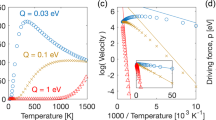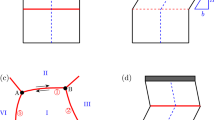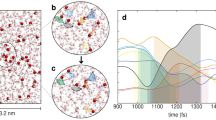Abstract
As current experimental and simulation methods cannot determine the mobility of flat boundaries across the large misorientation phase space, we have developed a computational method for imposing an artificial driving force on boundaries. In a molecular dynamics simulation, this allows us to go beyond the inherent timescale restrictions of the technique and induce non-negligible motion in flat boundaries of arbitrary misorientation. For different series of symmetric boundaries, we find both expected and unexpected results. In general, mobility increases as the grain boundary plane deviates from (111), but high-coincidence and low-angle boundaries represent special cases. These results agree with and enrich experimental observations.
This is a preview of subscription content, access via your institution
Access options
Subscribe to this journal
Receive 12 print issues and online access
$259.00 per year
only $21.58 per issue
Buy this article
- Purchase on Springer Link
- Instant access to full article PDF
Prices may be subject to local taxes which are calculated during checkout



Similar content being viewed by others
References
Zhang, H., Mendelev, M. I. & Srolovitz, D. J. Computer simulation of the elastically driven migration of a flat grain boundary. Acta Mater. 52, 2569–2576 (2004).
Huang, Y. & Humphreys, F. J. Measurements of grain boundary mobility during recrystallization of a single-phase aluminium alloy. Acta Mater. 47, 2259–2268 (1999).
Winning, M., Gottstein, G. & Shvindlerman, L. S. On the mechanisms of grain boundary migration. Acta Mater. 50, 353–363 (2002).
Upmanyu, M., Srolovitz, D. J., Shvindlerman, L. S. & Gottstein, G. Molecular dynamics simulation of triple junction migration. Acta Mater. 50, 1405–1420 (2002).
Zhang, H., Upmanyu, M. & Srolovitz, D. J. Curvature driven grain boundary migration in aluminum: molecular dynamics simulations. Acta Mater. 53, 79–86 (2005).
Adams, B. L., Kinderlehrer, D., Mullins, W. W., Rollett, A. D. & Ta’asan, S. Extracting the relative grain boundary free energy and mobility functions from the geometry of microstructures. Scripta Mater. 38, 531–536 (1998).
Saylor, D. M., Morawiec, A. & Rohrer, G. S. The relative free energies of grain boundaries in magnesia as a function of five macroscopic parameters. Acta Mater. 51, 3675–3868 (2003).
Janssens, K. G. F. Three dimensional space-time coupled cellular automata for the simulation of recrystallization and grain growth. Model. Simul. Mater. Sci. 11, 157–171 (2003).
Anderson, P., Grest, G. S. & Srolovitz, D. J. Computer simulation of normal grain growth in three dimensions. Phil. Mag. B 59, 293–329 (1989).
Rollett, A. D. & Raabe, D. A hybrid model for mesoscopic simulation of recrystallization. Comp. Mater. Sci. 21, 69–78 (2001).
Krill, C. E. III & Chen, L. Q. Computer simulation of 3-D grain growth using a phase-field model. Acta Mater. 50, 3057–3073 (2002).
Kuprat, A., George, D., Straub, G. & Demirel, M. C. Modeling microstructure evolution in three dimensions with Grain3D and LaGriT. Comp. Mater. Sci. 28, 199–208 (2003).
Raabe, D., Roters, F., Barlat, F. & Chen, L.-Q. Continuum Scale Simulation of Engineering Materials: Fundamentals - Microstructures - Process Applications (Wiley-VCH, Weinheim, 2004).
Sethian, J. A. Level Set Methods and Fast Marching Methods (Cambridge Univ. Press, Cambridge, 2002).
Van Swygenhoven, H., Farkas, D. & Caro, A. Grain boundary structures in polycrystalline metals at the nanoscale. Phys. Rev. B 62, 831–838 (2000).
Schonfelder, B., Wolf, D., Phillpot, S. R. & Furtkamp, M. Molecular-dynamics method for the simulation of grain-boundary migration. Interface Sci. 5, 245–262 (1997).
Ercolessi, F. & Adams, J. B. Interatomic potentials from 1st principles calculations—the force matching method. Europhys. Lett. 26, 583–588 (1994).
Plimpton, S. J. Fast parallel algorithms for short-range molecular dynamics. J. Comp. Phys. 117, 1–19 (1995).
Gottstein, G. & Shvindlerman, L. S. Grain Boundary Migration in Metals: Thermodynamics, Kinetics, Applications (CRC, Boca Raton, Florida, 1999).
Humphreys, F. J. & Hatherly, M. Recrystallization and Related Annealing Phenomena (Pergamon, Oxford, 1996).
Palumbo, G., Lehockey, E. M. & Lin, P. Applications for grain boundary engineered materials. JOM 50, 40–43 (1998).
Liebmann, B., Lücke, K., Graham, C. D., Cahn, R. W. & Dunn, C. G. Grain growth rates and orientation relationships in the recrystallization of aluminum single crystals. Trans. AIME 206, 1413–1416 (1956).
Gleiter, H. The mechanism of grain boundary migration. Acta Metall. 17, 565–573 (1969).
Gleiter, H. Theory of grain boundary migration rate. Acta Metall. 17, 853–862 (1969).
Shvindlerman, L. S., Gottstein, G. & Molodov, D. A. Grain boundary motion in pure metals: effect of interaction between adsorbed atoms at moving boundaries. Phys. Status Solidi A 160, 419–429 (1997).
Acknowledgements
Sandia is a multiprogram laboratory operated by Sandia Corporation, a Lockheed Martin Company, for the United States Department of Energy’s National Nuclear Security Administration under Contract DE-AC04-94AL85000.
Author information
Authors and Affiliations
Corresponding author
Ethics declarations
Competing interests
The authors declare no competing financial interests.
Rights and permissions
About this article
Cite this article
Janssens, K., Olmsted, D., Holm, E. et al. Computing the mobility of grain boundaries. Nature Mater 5, 124–127 (2006). https://doi.org/10.1038/nmat1559
Received:
Accepted:
Published:
Issue Date:
DOI: https://doi.org/10.1038/nmat1559
This article is cited by
-
Twinning-assisted dynamic adjustment of grain boundary mobility
Nature Communications (2021)
-
Direct imaging of atomistic grain boundary migration
Nature Materials (2021)
-
The dependence of precipitate morphology on the grain boundary types in an aged Al–Cu binary alloy
Journal of Materials Science (2021)
-
A mechanism of ferritin crystallization revealed by cryo-STEM tomography
Nature (2020)
-
Viewpoint on the Formation and Evolution of Annealing Twins During Thermomechanical Processing of FCC Metals and Alloys
Metallurgical and Materials Transactions A (2020)



